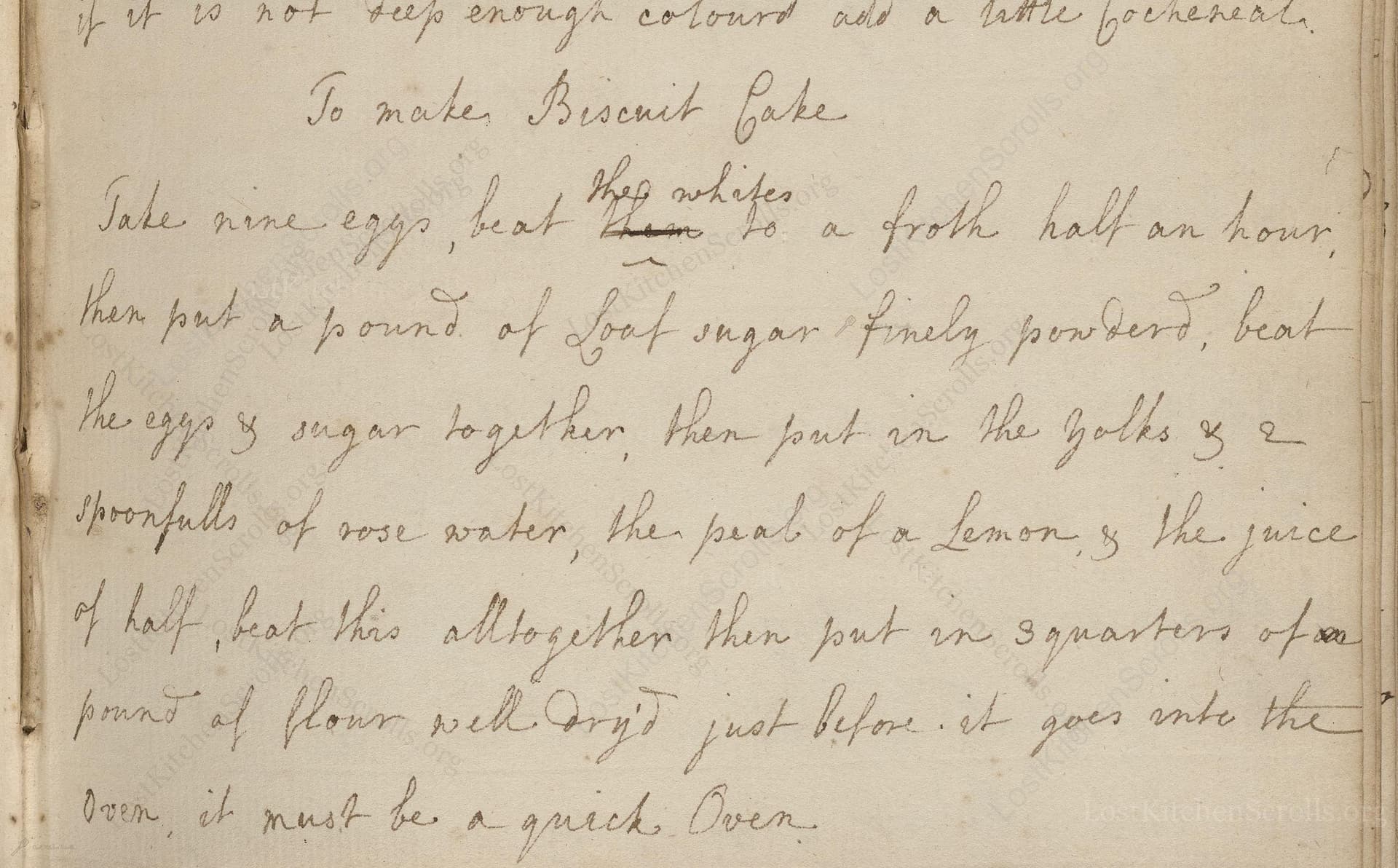To Make Biscuit Cake
From the treasured pages of Cookbook of Elizabeth Langley
Written by Elizabeth Langley

To Make Biscuit Cake
"Take nine eggs, beat the whites to a froth half an hour, then put a pound of loaf sugar finely powdred, beat the eggs & sugar together, then put in the Yolks & 2 spoonfulls of rose water, the peal of a lemon, & the juice of half, beat this altogether then put in 3 quarters of a pound of flour well Dry'd just before it goes into the Oven, it must be a quick Oven."
Note on the Original Text
The recipe is written in the direct, abbreviated prose typical of 18th-century manuscript cookery: practical directions with implicit steps and little explanation, intended for cooks familiar with the techniques. Words like 'powdred' and 'spoonfulls' are charmingly old-fashioned spellings, reflecting the lack of standardized English. Exact oven temperatures and times were usually unstated—'a quick Oven' simply meant a hot fire. Ingredients were measured by weight, using locally available loaf sugar, and instructions assumed the baker’s skill in reading the readiness of a batter or a bake.

Title
Cookbook of Elizabeth Langley (1757)
You can also click the book image above to peruse the original tome
Writer
Elizabeth Langley
Era
1757
Publisher
Unknown
Background
Step into the Georgian kitchen with Elizabeth Langley's 1757 culinary collection, where refined techniques and delightful recipes await those with a taste for historic gastronomy.
Kindly made available by
Folger Shakespeare Library
This delightful recipe hails from Elizabeth Langley, a woman active in 1757, a period when English baking was blossoming with the introduction of refined sugars and imported flavors such as rose water. The term 'biscuit cake' refers to a light sponge cake, a precursor to modern génoise or sponge cakes, relying on air incorporated into eggs for leavening, rather than chemical rising agents. The use of rose water and fragrant lemon peel reflects the 18th-century English love for aromatic ingredients, often found in cakes for special occasions or genteel gatherings.

In the 1750s, Langley would have used a large earthenware or metal bowl and an egg whisk (possibly made of twigs or wires) for beating the eggs by hand—a feat of endurance requiring up to half an hour’s vigorous motion. The sugar would be crushed with a mortar and pestle. A sieve or open-weave cloth would dry and sift the flour. Baking took place in a wood-fired oven, requiring quick work to transfer the delicate batter before it lost its loft.
Prep Time
20 mins
Cook Time
30 mins
Servings
12
We've done our best to adapt this historical recipe for modern kitchens, but some details may still need refinement. We warmly welcome feedback from fellow cooks and culinary historians — your insights support the entire community!
Ingredients
- 9 large eggs
- 1 pound (16 ounces) white caster sugar or finely ground loaf sugar
- 2 tablespoons rose water
- Zest of 1 lemon
- Juice of 1/2 lemon
- 12 ounces (about 3 cups) plain flour, dried
- Extra: Butter for lining the tin (modern addition)
Instructions
- To recreate this 18th-century biscuit cake, begin by separating 9 large eggs.
- Whip the egg whites until they form stiff peaks; this may take around 10 minutes with a stand mixer.
- Gradually add in 1 pound (16 ounces) of finely ground white sugar, whisking to incorporate.
- Next, beat in the yolks, 2 tablespoons of rose water, the finely grated zest of one lemon, and the juice of half a lemon.
- Mix gently to combine.
- Sift 12 ounces (about 3 cups) of plain flour, freshly dried if possible, and fold it lightly into the egg mixture.
- Pour into a lined cake tin and bake in a hot oven (preheated to 400°F) until golden and set, about 25-30 minutes.
- The resulting cake will be light, fragrant, and slightly chewy, much like an early sponge cake.
Estimated Calories
290 per serving
Cooking Estimates
It takes about 25-30 minutes to bake the cake in the oven, and about 20 minutes to prepare the ingredients and mix the batter. One serving contains approximately 290 calories, and this recipe serves 12.
As noted above, we have made our best effort to translate and adapt this historical recipe for modern kitchens, taking into account ingredients nowadays, cooking techniques, measurements, and so on. However, historical recipes often contain assumptions that require interpretation.
We'd love for anyone to help improve these adaptations. Community contributions are highly welcome. If you have suggestions, corrections, or cooking tips based on your experience with this recipe, please share them below.
Join the Discussion
Rate This Recipe
Dietary Preference
Culinary Technique

Den Bockfisch In Einer Fleisch Suppen Zu Kochen
This recipe hails from a German manuscript cookbook compiled in 1696, a time whe...

Die Grieß Nudlen Zumachen
This recipe comes from a rather mysterious manuscript cookbook, penned anonymous...

Ein Boudain
This recipe comes from an anonymous German-language manuscript cookbook from 169...

Ein Gesaltzen Citroni
This recipe, dating from 1696, comes from an extensive anonymous German cookbook...
Browse our complete collection of time-honored recipes



